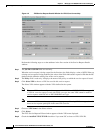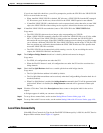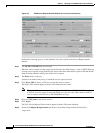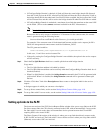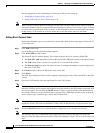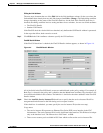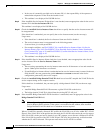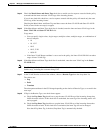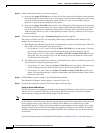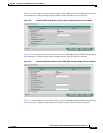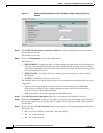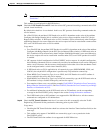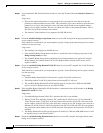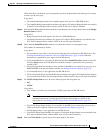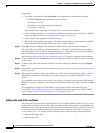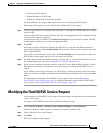
4-14
Cisco IP Solution Center L2VPN and Carrier Ethernet User Guide, 6.0
OL-21636-01
Chapter 4 Managing a FlexUNI/EVC Ethernet Service Request
Setting the Service Request Details
Step 19 If Push is the Rewrite Type, two text boxes appear:
a. In the text box Outer VLAN ID, enter an outer VLAN ID tag that will be imposed on the incoming
frames that fulfill the match criteria. All service requests created with this setting push a dot1q outer
tag on the incoming frames matching the match criteria. If a value is not provided, the push
operation is ignored and not configured on the device.
b. In the text box Inner VLAN ID, enter an inner VLAN ID tag that will be imposed on the incoming
frames that fulfill the match criteria. All service requests created with this setting push a dot1q inner
tag on the incoming frames matching the match criteria. The Inner VLAN tag cannot be pushed
without an Outer VLAN tag. That is, when pushing an Inner VLAN tag, the Outer VLAN tag also
must be defined.
Step 20 If Translate is the Rewrite Type, a Translation Type drop-down list appears.
The choices available in this list vary depending on the setting of the Match Inner and Outer Tags
attribute (set in a previous step).
a. If the Match Inner and Outer Tags check box is checked (true), choose a translation type of 1:1, 1:2,
2:1, or 2:2 from the Translation Type drop-down list.
–
If you choose 1:1 or 2:1, enter a value in the Outer VLAN ID text box that appears. The outer
tag of all the incoming frames that fulfill the match criteria will be translated to this ID.
–
If you choose 1:2 or 2:2, enter values in the Outer VLAN ID and Inner VLAN ID text boxes
that appear. The outer and inner tags of all the incoming frames that fulfill the match criteria
will be translated to these IDs.
b. If the Match Inner and Outer Tags check box is unchecked (false), choose a translation type of 1:1
or 1:2 from the Translation Type drop-down list.
–
If you choose 1:1, enter a value in the Outer VLAN ID text box that appears. The outer tag of
all the incoming frames that fulfill the match criteria will be translated to this ID.
–
If you choose 1:2, enter values in the Outer VLAN ID and Inner VLAN ID text boxes that
appear. The outer and inner tags of all the incoming frames that fulfill the match criteria will be
translated to these IDs.
Step 21 Clicked Next to save the settings in the FlexUNI Details window.
The Standard UNI Details window appears, as shown in Figure 4-6.
Step 22 Continue with setting the standard UNI link attributes in the next steps.
Editing the Standard UNI Attributes
The following steps cover setting the attributes in the Standard UNI Details window. In the case of a link
which is not set as a FlexUNI link (by not checking the FlexUNI check box in the Service Request
Details window), editing the link attributes begins with this window.
Note The attributes that appear in the Standard UNI Details window are dynamically configured by ISC. Some
of the attributes covered in the steps below might not appear in the window, depending on the policy and
service request settings or the link type. For example, if the MPLS core connectivity type of the
FlexUNI/EVC policy is VPLS or local, the pseudowire-related attributes will not appear. Also, setting
the link as FlexUNI or non-FlexUNI will change the attributes that appear in the window. In addition,
attributes are filtered based on device type (IOS or IOS
XR). These and other cases are noted in the steps,
for reference.
Some possible presentations of the Standard UNI attributes are shown in Figure 4-5 through Figure 4-7.



